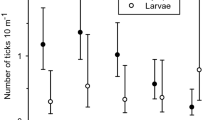Abstract
A carbon dioxide trap designed to captureIxodes ricinus over periods of up to 7 days is described. The trap compared favourably with blanket dragging and flagging in areas of high tick density, particularly on rough ground and for adult ticks; it was also surprisingly efficient for larvae. Ticks appeared to be captured throughout the 7-day trapping period. The maximum attraction distance recorded for adult female ticks was 3.5 m and for nymphs 1.0 m. Trapping rates were influenced by air temperature.
Similar content being viewed by others
References
Barnard, D.R., 1981. Comparison of populations of ticks free living on pasture and parasitic on cattle. Ann. Entomol. Soc. Am., 74: 507–511.
Campbell, A. and MacKay, P.R., 1979. Distribution of the American dog tick,Dermacentor variabilis (Say) and its small-mammal host in relation to vegetation in a study area in Nova Scotia. Can. J. Zool., 57: 1950–1959.
Eads, R.B., Smith, G.C. and Maupin, G.O., 1982. A CO2 platform trap for taking adultDermacentor andersoni (Acari: Ixodidae). Proc. Entomol. Soc. Wash., 84: 342–348.
Grays, J.S., 1980. Studies of the activity ofIxodes ricinus in relation to the epidemiology of babesiosis in Co. Meath, Ireland. Br. Vet. J., 136: 427–436.
Gray, J.S., 1981. The fecundity ofIxodes ricinus L. and the mortality of developmental stages under field conditions. Bull. Entomol. Res., 71: 533–542.
Gray, J.S. and Lohan, G., 1982. The development of a sampling method for the tickIxodes ricinus and its use in a redwater fever area. Ann. Appl. Biol., 101: 421–427.
Gray, J.S., Turley, T. and Strickland, K.L. 1978. Studies on the ecology of the sheep tick,Ixodes ricinus, in Co. Wicklow, Ireland. Ir. Vet. J., 32: 25–34.
Mermod, C., Aeschlimann, A. and Graf, J.F., 1973. Ecology and ethology ofIxodes ricinus Linnaeus 1758, in Switzerland (Acarina, Ixodoidea). First note—numerical fluctuations. Acarologia, 15: 197–205.
Milne, A., 1943. The comparison of sheep-tick populations (Ixodes ricinus L.).Ann. Appl. Biol., 30: 240–250.
Milne, A. 1950. The ecology of the sheep tickIxodes ricinus L. Microhabitat economy of the adult tick. Parasitology, 40: 14–34.
Philip, C.B., 1937. Six years intensive observation on the seasonal prevalence of a tick population in Western Montana. Public Health Rep. Wash., 52: 16–22.
Sutherst, R.W., Wharton, R.H. and Utech, K.B., 1978. Guide to studies on tick ecology. Division of Entomology, Commonwealth Scientific and Industrial Research Organization, Technical Paper No. 14.
Wilson, J.G., Kinzer, D.R., Sauer, J.R. and Hair, J.A., 1972. Chemo-attraction in the Lone Star tick (Acarina: Ixodidae). 1. Response of different developmental stages to carbon dioxide. J. Med. Entomol., 9: 245–252.
Author information
Authors and Affiliations
Rights and permissions
About this article
Cite this article
Gray, J.S. A carbon dioxide trap for prolonged sampling ofIxodes ricinus L. populations. Exp Appl Acarol 1, 35–44 (1985). https://doi.org/10.1007/BF01262198
Accepted:
Issue Date:
DOI: https://doi.org/10.1007/BF01262198




